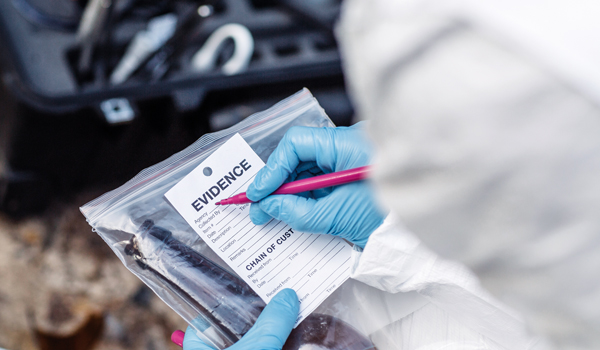Storing up confusion
Dr Carole McCartney and Louise Shorter argue that anything less than a robust and uniform system for police retention and disclosure of materials post-conviction, with appropriate training for all staff, risks ‘injustice’.
Criminal investigations can result in the collation of a huge volume of materials, both physical and digital. Even a ‘run of the mill’ investigation can generate tens of thousands of pages of data downloaded from multiple digital devices. As well as often copious paper documents, seized (and created) materials can range from microscopic particles to large vehicles or even body parts.
Following any resulting conviction, or a decision to close an unsolved case, there must be ongoing retention and storage of these materials. High-profile miscarriages of justice have often only been remedied when there has been defence access to materials post-conviction.
There is also an imperative for police forces to retain evidence in investigations where no perpetrator has been detected or convicted, to facilitate necessary cold case reviews.
Diligent storage and retention is especially critical in respect of physical materials that could be subject to forensic examination. With the progress of science and technology, and the interpretation of results, it is essential that such physical – and now often digital – materials are retained for future (re)evaluation.
In light of huge variance in retention practices across the 43 police forces of England and Wales, in 2017 the National Police Chiefs’ Council (NPCC) issued new national guidance – ‘Guidance Regarding the Storage, Retention and Destruction of Records and Materials that have been seized for forensic examination. Version 2.1’.
What is now needed is to ensure that this national guidance is followed and the resources required to properly adhere to the new rules are forthcoming. This should resolve the problem of the loss and destruction of materials that are critical in ensuring justice if the criminal justice process has resulted in a wrongful conviction, or a case has failed to be resolved.
Police recording and retention of materials
All police officers have a duty to record and retain material that may be relevant to an investigation, with obligations arising at the commencement of an investigation.
Crown Prosecution Service (CPS) guidance on exhibits also states that the prosecution and police are required to take “all proper care to preserve the exhibits safe from loss or damage”.
The Criminal Procedure and Investigations Act 1996 (CPIA) and supplementary Codes of Practice sets out more detailed guidance for the execution of this duty, and an officer in breach of the Code could face disciplinary proceedings. The CPIA Code of Practice helpfully defines ‘material’ as: “Material of any kind, including information and objects, which is obtained or inspected in the course of a criminal investigation and which may be relevant to the investigation. This includes not only material coming into the possession of the investigator (such as documents seized in the course of searching premises) but also material generated by them (such as interview records).”
The CPIA stipulates that all material must be retained (where an accused is convicted) until the individual is released from custody when incarcerated (or hospitalised), or six months from the date of conviction in all other cases. However, if there is an appeal in progress, all relevant material must be retained until the appeal is determined.
The revised Attorney General Guidelines on Disclosure reinforce this guidance on retaining relevant materials, stating: “The investigator should err on the side of caution in reaching that conclusion and should be particularly mindful of the fact that some investigations continue over some time and that what is incapable of impact may change over time. The advice of the prosecutor should be sought where appropriate.”
Further, the CPIA Codes of Practice state that any police officer has a duty to, “wherever practicable”, take steps to ensure material is retained, where as a result of developments in the case he becomes aware that previously considered ‘irrelevant’ material may now be relevant.
In December 2017, the NPCC published new national guidance on storage and retention/ destruction of materials (NPCC 2.1), written in conjunction with the CPS and the Forensic Science Regulator. The guidance makes clear that the investigator has a duty to ensure relevant material is recorded and retained in a suitable format, and explicitly states: “The purpose of retention of records and other materials is to allow there to be a future review, investigation, prosecution or appeal. It follows that retention must be approached in a manner which meets that aim.”
NPCC 2.1 provides guidance for police forces and independent forensic science providers (FSPs) and covers records and material (information and physical exhibits). It helpfully states that the guidance covers material and information recovered/seized by law enforcement agencies as a result of investigation into criminal investigations, submitted to and retained by FSP, as well as those retained within law enforcement property stores. The Guidance also refers to the Police and Criminal Evidence Act 1984 (PACE), CPIA (1996), the Human Tissue Act (2004), the Management of Police Information (MoPI), the Protection of Freedoms Act (2012), Regulation of Investigatory Powers Act (2000), Data Protection Act (2000) and Police Reform Act (2002).
Under NPCC 2.1, the minimum retention periods are: major and serious crime – 30 years (with ten year reviews advisable); volume crime – six years; and less serious crimes (simple possession of drugs cases and alcohol/drugs driving offences) – three years. The policy, however, also refers to MoPI guidance, which states that regardless of the severity of an offence, all records must be retained for an initial period of six years, with the new protocol recommending that the periods set out should apply whenever they are longer than the MoPI guidance.
Guidance on force policy for the retention of material is thus now best found in NPCC 2.1, yet information supplied by forces shows a picture of confusion across England and Wales, with forces following ad-hoc in-house policies, or outdated guidance with other aims in mind.
A year after the new guidance was issued, just two forces referred to this national policy in response to a Freedom of Information (FoI) request in 2018 regarding their retention policies and practice. Ten forces reported that they seek to comply with the MoPI guidance – but to apply MoPI to decision-making around the retention of physical material post-conviction is misguided, as the guidance is not intended to address this issue, as it makes clear.
An additional eight forces responded to say they use a combination of MoPI and the CPIA. Again, this is confusing as different guidance and codes of practice have been written for different purposes, but are being conflated and confused, running the risk of officers being unclear as to their duties and, unwittingly perhaps, destroying material.
Retention of scientific materials
With particular reference to scientific evidence, there is a further impetus for ensuring that all evidence is retained and stored adequately, with a full audit trail.
As scientific and technological developments have accelerated during the 20th century, the knowledge base upon which expert opinion(s) relating to such evidence is built has inevitably also advanced. The basis for any expert opinion relied upon during a police investigation, or at trial, is thus key and the retention of material post-conviction in whatever form (a physical item, which has undergone examination, scientist’s notes, samples, etc) need also to be preserved.
The shift in what is detectable by modern forensic techniques alone provides a compelling argument for retaining all material post-conviction. Materials retained from scenes that may not have yielded probative evidence at the original investigation stage, may be re-tested using different/improved techniques later, with different results.
There has been a worrying picture of inconsistency across England and Wales, with confusion over what should be retained, and how.
In reference to reviewing cases post-conviction, CPS policy states that “a review may be required as a consequence of a subsequent trigger, which requires the reconsideration… and an assessment whether justice is served by allowing such convictions, or decisions, to stand”.
One of the non-exhaustive, indicative lists of ‘broadly-defined triggers’ includes where a new scientific breakthrough raises questions over the safety of earlier convictions. The first essential safeguard must be that the material upon which any scientific evidence is constructed is retained, and stored adequately. The Court of Appeal is unable to perform its role in assessing whether advancement in knowledge or a technique renders a conviction unsafe, if it is not possible to revisit the material in question because it has been ‘lost’ or destroyed.
The retention of scientific material nationally changed following the closure of the Forensic Science Service (FSS). Concern that archives would be fragmented upon closure of the FSS led to the House of Commons Science and Technology Committee recommending in 2011 that “the existing archives must physically remain as a single, accessible resource”.
The Government was eventually persuaded to create a new facility, the Forensic Archive Ltd (FAL), as the storage solution to forensic files and scientific exhibits. Material held across various FSS laboratories and stores was brought together in vast hangars in the Midlands. Further calls for all scientific material, created by commercial FSPs in the post-FSS era, to also be held securely and centrally at FAL went unheeded.
In 2011, the House of Commons Science and Technology Committee had recommended that FSPs be allowed to send this material to FAL but the Home Office did not consider it “appropriate during the transition to design a completely new archiving system encompassing material from private FSPs”. Instead, the Home Office placed the burden on police forces to archive their forensic files and materials, for which, arguably, they had neither the expertise nor budget, and until NPCC 2.1, no national policy for this new police role.
Following efficiencies made during the cataloguing and destruction process, the annual budget for FAL has halved from £1.95 million in 2012 to £1 million in 2016. The archive employs just seven archivists and a manager working on one site. However, there remains evidence of some concern around who should be paying for the FAL.
The safe retention of historic material is clearly valued, with the House of Commons Science and Technology Committee specifically referencing the need to investigate and remedy miscarriages of justice as one important justification. Despite this, the Home Office Review of FAL in April 2016 concluded that, by 2021, “the costs of maintaining and running FAL will no longer represent value for money”.
This evaluation may need re-visiting, particularly as the plan to house only exhibits existing when created, became untenable when FSPs started to go bankrupt, creating a panic over what should happen to their case files. Thus, a new policy in February 2019 re-positions the FAL as ‘archive of last resort’ and it can now accept material into the archive when a private provider leaves the market.
The historic practice of returning physical items to police forces (clothing, weapons, etc) post-examination has thus expanded since the FSS closure to include the bulk of material created by scientists based at commercial FSPs. The additional burden placed on forces, to safeguard all forensic material in addition to property without additional funding, has created difficulties for cash-strapped forces.
This material also requires an audit trail to evidence appropriate handling. According to NPCC guidelines, FSPs should retain DNA extracts and case-files but a lack of clarity has led to reports of inappropriate destruction of even this potentially vital material. Physical size, ownership and the value of an item, among other things, preclude the retention of all possible materials involved in a police investigation.
While some forces have reported keeping bulky and expensive items such as a car, scaffolding poles, and even a shed, for more than a decade in police storage, these reports are exceptional. Equally, items of sentimental value are a difficult area for an officer trying to balance the needs of the victim or family, alongside criminal justice requirements and clear national guidelines are required to avoid confusion.
Practical steps could and should be taken if an item is to be returned – forensic taping or swabbing that effectively lifts any evidential value onto a smaller, more easily managed item, which could be retained for future testing.
Future issues
The European Court of Human Rights has ruled that Article 6(3)(b) requires the State to provide for the accused to have “at his disposal, for the purposes of exonerating himself, or of obtaining a reduction in his sentence, all relevant elements that have been or could be collected by the competent authorities”. Time-sensitive evidence not gathered, or not retained, is forever lost to individuals who wish to appeal their conviction.
High-profile appeals following new forensic testing illustrate the important role that post-conviction disclosure of retained materials can play in remedying wrongful convictions. Hundreds of wrongfully convicted prisoners, domestically and internationally, have had their convictions overturned when there have been further investigations or inspection of materials (that were often available at trial) in light of developing techniques and technologies. Cases often involve the use of scientific techniques now outdated or superseded by advances in both technology and interpretative understanding. It is therefore imperative that there is access to all relevant material for experts to re-evaluate. It follows that if access to material is essential then proper storage of that material is also vital.
Although thoughtful compromises are needed when balancing the needs of different parties, it should also be noted that it is impossible for any accurate prediction to be made about what material might usefully be retained for a new scientific technique, which has not yet been discovered.
The retention of material post-conviction is paramount for anybody striving to have their wrongful conviction overturned, who may need to rely upon new scientific techniques or interpretation. It is also essential for any cold case reviews that need to be undertaken. Evidence thus needs to be retained, and properly stored; if it is not, re-investigations are rendered impossible.
There has been a worrying picture of inconsistency across England and Wales, with confusion over what should be retained, and how – confusion that should have been ameliorated by the national NPCC guidance. However, knowledge and application of this guidance looks to be patchy at best.
Further, while NPCC 2.1 benefits from being a clear policy, it should be amended to reflect the increase in sentencing severity, which has occurred over the past decade, and be updated to reflect this, so that all material in a life sentence case should be retained during the life of the sentenced person, or 30 years, whichever is longer.
Recent guidance confirms that all case materials are to be returned to police forces by FSPs, but the previous lack of clarity over this policy has led to reports of inappropriate destruction.
It is essential that both FSPs and forces are aware of their responsibilities. In addition, the operation and future of the FAL remains uncertain – the Home Office must now take informed decisions about its long-term future.
The combination of developing science and technology, and a greater understanding of the many techniques that are utilised, including their validity and reliability, means that expert opinions are often revisited and found, using modern techniques, to be flawed, or at least less sophisticated or accurate than can be achieved today. It is then vital to appreciate that scientific opinion presented in court today may be superseded tomorrow, thus making essential the retention of all material that could be subjected to new tests or interpretation in the light of new information.
This is especially critical to the success of cold case reviews. The ‘system’ for retaining, storing, and accessing material for post-conviction challenges needs to be uniform, transparent, robust and impartial.
NPCC 2.1 has started the process of creating such a system and should be disseminated widely to ensure that every member of staff who may need to decide what should be retained post-conviction is appropriately informed and trained. Anything less risks injustice.
Dr Carole McCartney is a Professor of Law and Criminal Justice at Northumbria University. She researches in the areas of criminal law and evidence (particularly forensic science), and criminal justice more widely.
Louise Shorter (MA) is CEO of Inside Justice, a registered charity that investigates miscarriages of justice.




